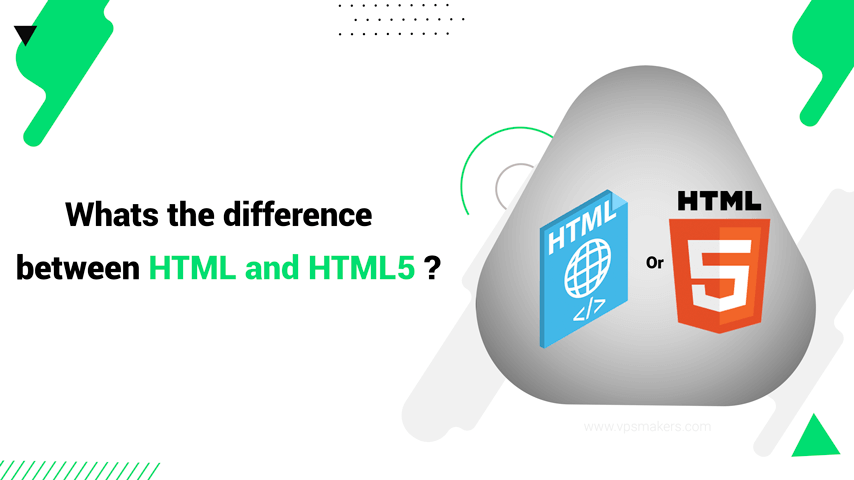What’s the difference between HTML and HTML5?
In this article, we will provide a detailed comparative analysis of HTML and its successor HTML5. We will outline their key features, advantages, limitations, and impact on the industry. The goal is to illuminate how dramatically HTML5 has transformed the landscape by modernizing the foundation from which the entire web is built.
What is HTML?
HTML stands for Hypertext Markup Language. It is the standard language used to define the structure and layout of web pages. Here are some of the core things to know about HTML:
| Property | Specifications |
|---|---|
| Basic Page Structure | -HTML uses tags like < html >, < head >, < body > to define the overall structure of a web page. -Elements like < h1 >-< h6 > define the headings, < p > defines paragraphs, and < ul >/< ol >/< li > create unordered and ordered lists. |
| Fundamental Tags | -Common text-related tags include < b > for bold text, < i > for italics, < u > for underline, and < br > for line breaks. -Tags such as < a > define links, < img > adds images, and < div > helps structure content. |
| Ease of Use | -HTML code is straightforward to write and understand. It uses plain text tags and organized elements to define semantics. -Web pages can contain styling details through a separate CSS stylesheet, keeping HTML focused on content structure. |
| Browser Interpretation | -Browsers like Chrome, Firefox, and Safari understand HTML and how to display tags and content on the page. -This allows websites and web apps to work consistently across different devices. |
| Evolution of HTML | -Newer HTML versions like HTML5 have added many features, but the core concept of using tags remains the same. |
What is HTML used for?
HTML is used to structure and format web content to display different parts of a website to the user. These factors define the arrangement of titles, paragraphs, images, and links in one or more web pages, and then you can create attractive colors and designs for your audience through CSS.
To display your website, you must host your website through Windows VPS by installing Plesk, you can start your website and you can also read How to install Plesk on Windows Server.
How does HTML work with CSS?
After you understand the HTML elements, you can achieve a general structure by putting them together. In the first step, you need a host that you can get from many sites, but if you don’t want to pay, you can create a local host environment by installing Xampp software and running your HTML elements. You can also use the w3schools website for ease of practice.
Below is an example of the general HTML format for you:
<!DOCTYPE html>
<html>
<title>Page Title</title>
</head>
<body>
<h1>This is a Heading</h1>
<p>This is a paragraph.</p>
</body>
</html>
The output of the above elements is as follows:

Note: To display your content to users, you must place them in the middle of a single <body> so that users can see useful information from your site.
Now let’s see what happens when we apply CSS to HTML:
<head>
<style>
body {
background-color: lightblue;
}
h1 {
color: white;
text-align: center;
}
p {
font-family: verdana;
font-size: 20px;
}
</style>
</head>

Note: Be careful not to put CSS styles in the <body> section, the place where the styles are placed is in the <head> section.
Differences between HTML and HTML5
As the internet evolved, so too did the standards that power the World Wide Web experience users enjoy every day. HTML, the original markup language, served as the foundational standard for early web development yet saw several changes emerge through successive iterations. Among the most pivotal revisions was the release of HTML5—a significant upgrade that introduced critical new capabilities.
| Property | HTML vs HTML5 |
|---|---|
| Markup Language | While HTML established the essential structural elements and semantics of web documents, HTML5 provided a much more robust and sophisticated set of semantic features for clearly describing content. Tags like < header >, < nav >, and < article > enhanced organizational clarity. |
| Audio/Video Support | HTML requires third-party plugins like Flash for multimedia, leaving web designers dependent on other code. HTML5 incorporated native support for embedded audio and video directly in code without additional software. |
| Mobile Optimization | HTML5 was engineered with mobile-friendliness and responsive design in mind. It includes features tailored to touch interactions and smaller screens integral to the proliferation of smartphones. |
| Drag/Drop Interaction | The ability to seamlessly integrate drag-and-drop functionality arrived through HTML5, enabling richer interactive user experiences right within browsers. |
| Rich Media Support | Beyond audio/video, HTML5 offered built-in graphic/image display through elements like < canvas >, eliminating the need for third-party image libraries or plugins. |
HTML5 represented a giant leap that modernized web standards and empowered designers and developers to build a more immersive and capable internet through improved semantics, interactivity and built-in multimedia. Its impact revolutionized the digital landscape.
Advantages of HTML5 over HTML
Here are some critical advantages of HTML5 over traditional HTML:
| Advantages | Description |
|---|---|
| Semantics and Structure | HTML5 introduced semantic elements that describe the purpose of content like < header >, < nav >, < article >, < aside >, < footer >, etc. This provides clearer structure and meaning. |
| Multimedia Capabilities | HTML5 allows native playback of audio and video without external plugins. It also supports vector graphics with < canvas >. |
| Mobile Friendliness | HTML5 was designed with mobile devices in mind. Features like responsive design, touch, geolocation, and local storage maximize usability across devices. |
| Offline and Storage | Applications can now work offline through caching strategies. Local storage APIs allow persistent data storage on the user's device. |
| Forms and Validation | New input types make forms more intuitive, while built-in validation helps ensure complete/accurate submission. |
| Graphics and Animation | The < canvas > element allows dynamic 2D drawing and animations right on the page without Flash or third-party tools. |
| Cross-Browser Compatibility | HTML5 aims to establish standards that are consistently supported on all modern browsers for a smooth user experience everywhere. |
| Developer Experience | HTML5 simplifies the integration of rich media and facilitates page building overall. Features like drag-and-drop also enhance productivity. |
HTML5 represents a significant upgrade that enhances the entire web ecosystem through a common language for structuring content in a way that’s optimized for next-gen experiences across devices and platforms. It truly revolutionized how the internet works.
summary
this examination of HTML and its updated successor, HTML5, the progression in capabilities from the former to the latter is readily apparent. While HTML established the basic building blocks of web content and website architecture, HTML5 has undertaken a quantum leap forward by supporting an impressive range of cutting-edge features.
To be sure, HTML5 still has room to improve and solidify standards further. Yet, it has already demonstrated its potential to revolutionize how web content is both delivered and consumed. The widespread industry adoption of its capabilities speaks volumes about HTML5’s status as the dominant standard-bearer.
In conclusion, HTML was the spark that ignited the web’s initial proliferation. HTML5 has taken this to the next level as the torch that propels the web’s continuous advancement well into the future, empowering developers and delighting users alike. Its impact ensures HTML5 will remain the cornerstone markup language for websites and applications to come.
If you want to learn more, you can read the article How to Install XAMPP on a Linux VPS in 5 Minutes

